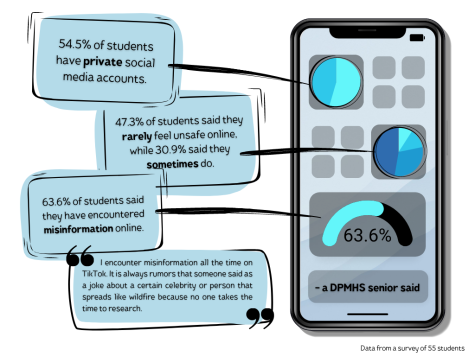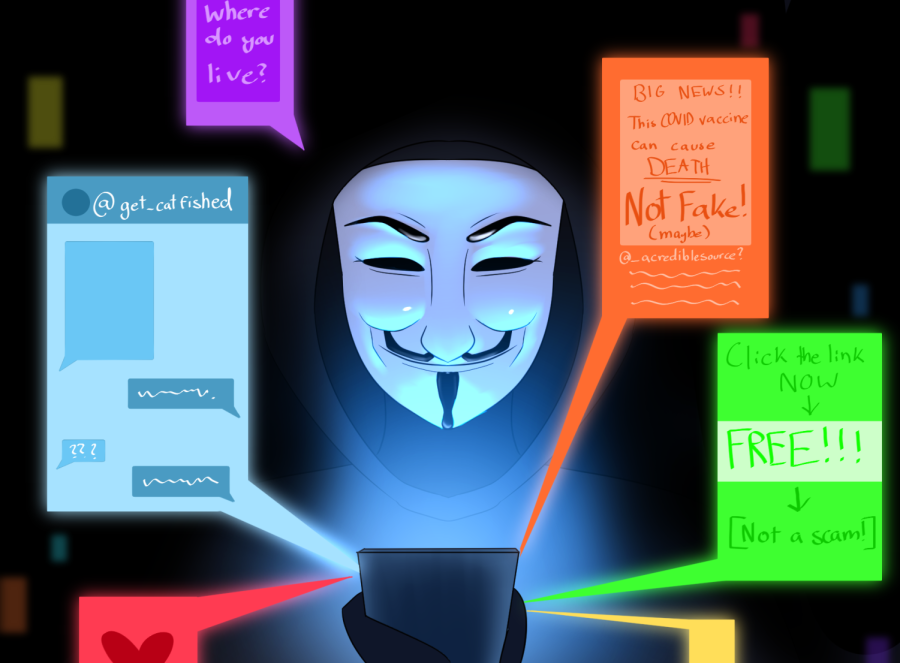Illustration by Desiree Spurkel
In a poll of 55 Daniel Pearl Magnet High School students, 47.3% of participants said they rarely feel unsafe online while 30.9% said they often feel unsafe. Additionally, 63.6% said they have encountered misinformation online.
Online threats, misinformation grow along with new generation
February 6, 2023
Senior Sarah Esser initially got social media in sixth grade to better connect with her friends, unaware that she would also be left open to the eyes of anyone who stumbled upon her account.
“I get a lot of older men commenting on my stuff,” said Esser, who’s accumulated over 2,000 followers on Instagram. “It’s really disgusting.”
In late 2022, a Riverside catfishing incident took hold of national headlines and showed the real-life risks of engaging with strangers online. A Virginia police officer befriended a teen girl online using a falsified persona and obtained her personal information before he drove to her home, killed three of her family members and abducted her. Similar interactions to the one depicted here, while not to this extent, occur behind the scenes every day.
A study done by technology nonprofit Thorn shows that 40% of all minors online have been approached by someone they didn’t know. A similar study conducted by Smart Social revealed that 50% of people ages 15-24 have experienced abusive behavior online.
“(Uncomfortable online interactions) happen a lot,” said senior Giselle Khalil, who has over 2,000 followers on Instagram. “Sometimes people make fake accounts to say weird things (about me). I’ve kind of learned to just ignore it after a while.”
The aftermath of the COVID-19 pandemic has left more teens than ever dependent on social media for interactions and information, with roughly one in three saying some of their closest friends are those made online. This also enables anyone with the necessary means to access those who live their online lives openly. Junior Lauren Galvez has done her best to stay out of the public eye.
“(I got) social media because I wanted to connect more with my friends,” Galvez said. “(My account) is public but I purposely don’t add myself to any of the pictures or videos I put out.”
The results of a study from the World Economic Forum state that the most popular social media platforms among this generation’s teens are YouTube, TikTok and Instagram. A poll consisting of 55 Daniel Pearl Magnet High School (DPMHS) students widely supports this, with 21.8% of students saying they use YouTube, 52.7% saying they use TikTok and 87% saying they use Instagram. Over half of the participants, 54.5%, say they choose to keep their main accounts private.

“If someone (I don’t know) requests to follow me,” a freshman who took the poll said. “I don’t let them. I only follow my friends, family and educational accounts.”
When asked how they protect their digital footprint online, 53% of respondents said they either refrain from posting things pertaining to their lives or review things before they post.
“Stuff on social media stays on there forever,” sophomore Donovan Ochoa said. “There’s no way of it just never existing. So I think it’s important to just not post stuff that your future self wouldn’t be proud of.”
Out of all the poll respondents, 63.6% also said they’ve encountered misinformation before, with the most notable topics they’ve seen including rumors pertaining to influencers and the COVID-19 virus. Massachusetts Institute of Technology noted in a 2018 study that misinformation on Twitter, which is used by 32.7% of DPMHS students, often spreads faster than the facts. The same study notes that most hoaxes are propelled by people rather than bots.
The News Literacy Project offers programs aimed to help people look into the legitimacy of questionable pieces of information online. Students, like those in DPMHS’ photography class, can use this resource to fact-check the sources they see online and dig deeper into a topic rather than accept the surface information they may come across.
“There’s a lot of things that go into media and through social media,” said sophomore Genesis Cuellar-Figueroa, who has over 1,000 followers on Instagram. “Sometimes there can be false information that can be spread and it can make it this big thing that could possibly harm someone or ruin someone’s reputation as well.”
With these increasing digital dangers, from misinformed young minds to frequent online threats, more teenagers are questioning whether or not social media is really worth the risk of putting their personal safety on the line.
“There’s a lot of age ranges on social media,” Cuellar-Figueroa said. “I guess that’s a reason why (people) should advocate more for safety, because there’s a lot of people who have no good intentions and they just love bothering people. So safety is something that’s pretty important when it comes to social media.”
Managing Editor Rikka Dimalanta contributed to this report.

